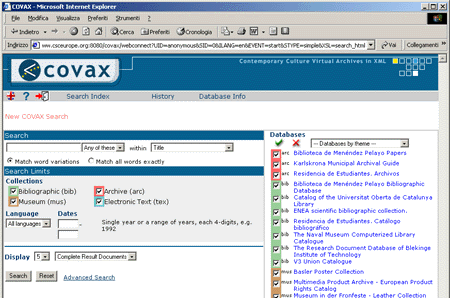|
ERCIM News No.49, April 2002
|
COVAX: an Internet Access to Libraries, Archives and Museums
by Luciana Bordoni
COVAX is testing the use of XML to combine document descriptions with digitised surrogates of cultural documents. The aim is to build a global system for search and retrieval, increasing accessibility via the Internet to the digital collections of memory institutions regardless of their location.
The objectives of the EU-funded COVAX project are:
- to build a web service for search and retrieval of contemporary European cultural documents from memory institutions
- to make existing library, archive and museum document descriptions accessible over the Internet
- to assist memory institutions to provide access to their collections, regardless of document type or collection size
- to implement standards and achieve interoperability between retrieval systems operating in the cultural heritage area.
Partners in the project include technology developers and providers (public research organisations and private companies) and content owners (memory institutions). The content owners have collections of varying type and size, catalogued using a variety of library, museum and archiving systems. The project is assessing ways to improve access to these collections by converting samples of existing data into a limited set of common structured formats, each of which can be expressed using XML (eXtensible Markup Language).
According to the philosophy adopted by the project, future catalogs for libraries, museums and archives will be stored in a variety of XML formats instead of proprietary formats, or formats such as MARC which have not gained wide acceptance outside of their development context. Since much material is already described in machine-readable form, the project worked on developing tools to convert such descriptions to XML and to integrate them with native XML data in order to build user-friendly websites and data archives.
COVAX is converting existing files into homogeneously-encoded document descriptions of bibliographic records, archive finding aids, museum records and catalogs, and electronic texts using XML and adapting the different document type descriptions (DTDs) currently used for library cataloguing (MARC), archive finding aids (EAD), museum data (AMICO DTD) and cultural texts (TEIlite). COVAX is designed to form a network of XML repositories structured in a distributed database and will act as a meta-search engine, offering access to all types of cultural data.
The COVAX system has implemented a multilingual user interface to access different data (catalog records, finding aids, etc.) and documents (manuscripts, electronic texts, images, etc). The project is not creating new standards but will adopt existing standards and concepts (XML, existing DTDs, http, etc.). The Z39.50 protocol provides a conceptual basis for communication between the multilingual user interface and meta-search engine and Dublin Core Metadata Element Set elements as cross-domain access points.
 |
Search in the COVAX Prototype. |
A comprehensive set of documents for the implementation of the prototype was selected. It contains a wide variety of documents, descriptions, formats and databases: standard and non-standard bibliographic records (including five different MARC formats), four different structures for archive and museum finding aids and information in six different languages (Catalan, Italian, English, German, Spanish, Swedish).
COVAX is intended to satisfy the needs of the general public as well as professional users. User requirements are basically structured around these criteria:
- the user must be able to select any or all of the COVAX databases for his/her search
- the user must be able to select any or all document types for his/her search
- the user interface must permit simple searches, suitable for the general public, or more complex searches, for specialised users.
COVAX partners have implemented two different database models: ad hoc XML databases, or existing non-XML repositories. In the latter case, information is retrieved from the original database and transformed into XML format before presenting it to users. To summarise, COVAX is not only incorporating XML as a basic standard but also integrating other standards, and adapting them to XML.
COVAX partners have implemented XML repositories using two software packages, Tamino from Software AG, a COVAX technical partner and TeXtML from IXIAsoft. Sites have been established in London, Rome, Salzburg, Graz and Madrid.
COVAX will test the benefits of XML to encode and process cultural heritage information, explore the feasibility of converting existing cultural heritage descriptions into XML encoded information, adapt cultural information systems to user requirements and contribute to the extension of standards for presentation and dissemination of cultural heritage.
Ultimately, it will enhance access to cultural heritage (one of Europe's most important competitive advantages) for all citizens.
Link:
http://www.covax.org/
Please contact:
Luciana Bordoni, ENEA/UDA, Italy
Tel: +39 06 3048 3503
E-mail: bordoni@casaccia.enea.it
